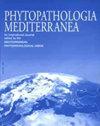墨西哥葡萄藤相关种Lasiodiplodia的特征
IF 1.9
3区 农林科学
Q2 AGRONOMY
引用次数: 9
摘要
葡萄枯萎病(Botryosphaeria dieback)是最常见的葡萄树干疾病之一,由葡萄科真菌引起。真菌主要通过修剪伤口侵入葡萄血管系统,并引起溃疡和坏死病变,导致葡萄衰退和死亡。据报道,席溴Lasiodiplodia是葡萄藤的一种高毒力病原体,此前在墨西哥葡萄园也有报道。Lasiodiplodia的分类学最近进行了修订,增加了新的物种,有些被简化为同义词。本研究旨在描述墨西哥索诺拉州和下加利福尼亚州产生葡萄藤枯萎症状的二倍体Lasio。利用系统发育标记tef1-α和ITS区,鉴定了巴西Lasiodiplodia brasiliensis、粗糙乳杆菌、甜菜乳杆菌和吉林乳杆菌。甜菜Lasidiplodia exigua是最常见的物种。巴西Lasiodiplodia brasiliensis和吉林L.gilanensis对‘赤霞珠’植物的毒力很强,而甜菜L.exigua和吉林L.jilanensis的毒力较低,粗孢L.crassispora在接种后2个月没有产生病变。Lasiodiplodia spp.的最适温度为28°C,但四个物种都能生长到37°C,而L.exigua的分离株在40°C时生长缓慢。这是对墨西哥葡萄园中四种二倍体Lasio的首次报道。本文章由计算机程序翻译,如有差异,请以英文原文为准。
Characterization of Lasiodiplodia species associated with grapevines in Mexico
Botryosphaeria dieback is one of the most prevalent grapevine trunk diseases (GTDs), and is caused by fungi in the Botryosphaeriaceae. Fungi invade grapevine vascular systems mainly through pruning wounds, and cause cankers and necrotic lesions, which lead to grapevine decline and death. Lasiodiplodia theobromae has been reported as a highly virulent pathogen of grapevine, and was previously reported in Mexican vineyards. The taxonomy of Lasiodiplodia was recently revised, adding new species, and some were reduced to synonymy. This study aimed to characterize Lasio-diplodia producing grapevine dieback symptoms in Sonora and Baja California, Mexico. Using the phylogenetic markers tef1-α and ITS regions, Lasiodiplodia brasiliensis, L. crassispora, L. exigua, and L. gilanensis were identified. Lasidiplodia exigua was the most prevalent species. Lasiodiplodia brasiliensis and L. gilanensis were very virulent to ‘Cabernet Sauvignon’ plants, while L. exigua and L. gilanensis were less virulent, and L. crassispora did not produce lesions at 2 months post-inoculation. The optimum temperature of the Lasiodiplodia spp. was 28°C, but all four species grew up to 37°C, and the isolates of L. exigua grew slowly at 40°C. This is the first report of the four of Lasio-diplodia species in vineyards of Mexico.
求助全文
通过发布文献求助,成功后即可免费获取论文全文。
去求助
来源期刊

Phytopathologia Mediterranea
生物-植物科学
CiteScore
4.40
自引率
8.30%
发文量
28
审稿时长
6-12 weeks
期刊介绍:
Phytopathologia Mediterranea is an international journal edited by the Mediterranean Phytopathological Union. The journal’s mission is the promotion of plant health for Mediterranean crops, climate and regions, safe food production, and the transfer of new knowledge on plant diseases and their sustainable management.
The journal deals with all areas of plant pathology, including etiology, epidemiology, disease control, biochemical and physiological aspects, and utilization of molecular technologies. All types of plant pathogens are covered, including fungi, oomycetes, nematodes, protozoa, bacteria, phytoplasmas, viruses, and viroids. The journal also gives a special attention to research on mycotoxins, biological and integrated management of plant diseases, and the use of natural substances in disease and weed control. The journal focuses on pathology of Mediterranean crops grown throughout the world.
The Editorial Board of Phytopathologia Mediterranea has recently been reorganised, under two Editors-in-Chief and with an increased number of editors.
 求助内容:
求助内容: 应助结果提醒方式:
应助结果提醒方式:


